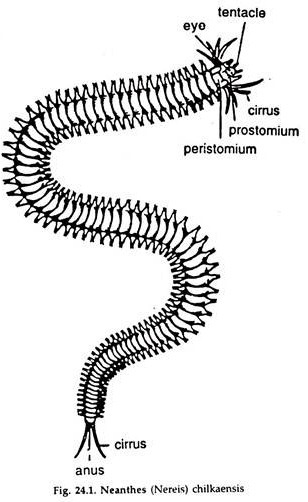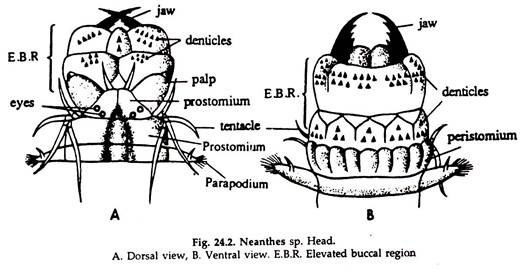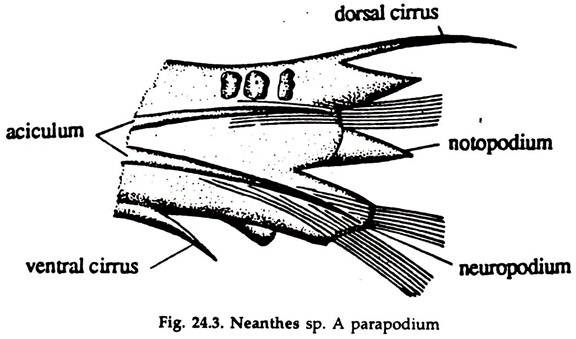In this article we will discuss about the morphology of neanthes (sandworm). This will also help you to draw the structure and diagram of neanthes (sandworm).
1. The body is long, narrow, dorsoventrally flattened, bilaterally symmetrical with a tapering posterior and a broader anterior end (Fig. 24.1).
2. The size varies from 300 to 400 mm in length and 2 to 6 mm in width.
ADVERTISEMENTS:
3. Colour usually greenish-blue with tinges of red or yellowish brown.
4. A distinct head is present at the anterior end of the body. The rest of the body or the trunk is divided by ring-like narrow grooves into a series of segments, the Metameres or somites, arranged in a linear series.
5. The number of metameres varies from 80 to 200.
6. The head is differentiated into an anterior prostomium and a posterior peristomium (Fig. 24.2):
a. The prostomium is a narrow, nearly triangular fleshy outgrowth situated mid-dorsally in front of the mouth.
b. The peristomium is a large ring-like structure with a transverse ventral mouth and is formed by the fusion of first two body segments. It forms the lateral and ventral margins of the mouth.
c. The head bears several sense organs.
The important sense organs are prostomial eyes, prostomial tentacles, prostomial palps, nuchal organs and peristomial cirri:
ADVERTISEMENTS:
i. Prostomial eyes are four and dorsal in position. They are round, black and sensitive to light.
ii. The tentacles are a pair of short, cylindrical tactile organs projecting from the anterior border of the prostomium.
iii. The palps are paired, long and jointed and tactile in function, located on the ventral side of the prostomium.
iv. The nuchal organs are ciliated pits of doubtful function, one on each side of the prostomium.
v. Four long, slender cirri, tactile in function are present on the anterolateral border of the peristomium.
7. The segments of the trunk are almost similar in structure except the last one.
8. Each body segment except the anal bears on either lateral side a flat, fleshy, hollow and vertical flap-like outgrowth, the Para podium (Fig. 24.3):
i. A Para podium is a biramous appendage consisting of an upper or dorsal blade, the notopodium and a lower or ventral blade, the neuropodium. Each blade is further subdivided into two lobes, an upper and a lower.
ADVERTISEMENTS:
ii. The dorsal margin of the notopodium is produced into a short, cylindrical, tactile appendage, the dorsal cirrus. A similar structure, ventral cirrus is present on the ventral margin of the neuropodium.
iii. Both the noto and neuropodium have a bundle of bristle-like setae or chaetae, lodged in setigerous or chaetigerous sac formed by the invagination of the epidermis. The setae are moved by strands of muscle fibres present in the Para podium.
iv. A stout, straight, thick and dark coloured chitinous rod called aciculum, deeply embedded in the Para podium is present in the middle of each bundle of setae. The two acicula constitute the endoskeleton of the Para podium and serve to support and for attachment of the setal muscles.
9. The Para podia of the mid-body segments are largest and decrease in size towards both the anterior and posterior ends.
10. On the ventral side of the body, laterally and close to the base of each Para podium a minute opening, the excretory pore or nephridiopore is present.
11. The last segment is elongated, devoid of Para podia and bears a pair of long, ventrally placed anal cirri and the anus. The segment is called tail or anal segment or pygidium.


